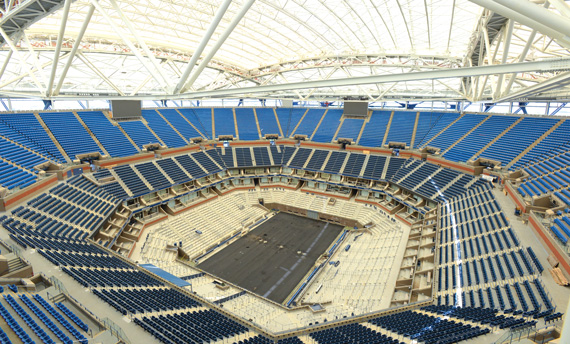There’s a famous passage in “The Great Gatsby” that begins, “About half way between West Egg and New York the motor-road hastily joins the railroad and runs beside it for a quarter of a mile, so as to shrink away from a certain desolate area of land. This is a valley of ashes — a fantastic farm where ashes grow like wheat into ridges and hills and grotesque gardens…”
The valley of ashes was not fictional. There was a time when anyone driving out from Manhattan to Queens would have passed this scene of biblical desolation, which, according to an old article from the New York Times, was a breeding ground for dog-sized rats and swarms of mosquitoes.
All that changed in the late 1930s, when Queens went from being a largely rural outer borough whose salt marshes served as a dumping ground for the city’s coal furnace refuse to the site of the 1939 New York World’s Fair, a parade of progress that literally supplanted the valley of ashes. A generation later, the 1964 World’s Fair was also held in Flushing Meadows Corona Park. In the 1970s, Flushing Meadows became home to the US Open tennis tournament when it moved from Forest Hills to its present location near Willets Point and Citi Field.
This complex, officially known as the Billie Jean King National Tennis Center (NTC), has 22 tennis courts, including four stadiums, spread out over 42 acres. Over the past few years, the grounds, which are owned by the Parks Department and leased to the United States Tennis Association, have been — and for the next few years will continue to be — the beneficiary of a functional albeit thorough $550 million redevelopment that includes the building of new structures as well as the modification of existing ones, together with a re-landscaping of the grounds.

Matt Rossetti
The US Open lasts only two weeks, during which some 750,000 fans pour in to see the annual Grand Slam tournament. During the rest of the year, the complex is used as a city-run tennis center where anyone from a novice to a professional can play.
All of the alterations to the campus are the work of Rossetti, an architecture firm led by president Matt Rossetti. Over the past few decades, Rossetti has been devoted almost exclusively to sports complexes, starting with the Palace at Auburn Hills, which was completed in 1988, as well as the Los Angeles Lakers’ new training facility and headquarters. They also lay claim to having designed more Major League Soccer venues than any other firm in existence.
Three of the stadiums at the NTC are entirely new structures: Court 17, which opened in 2011, and the Louis Armstrong and Grandstand Stadiums, both of which are due to open at the end of August. The biggest of the venues, however, is the Arthur Ashe Stadium, which, instead of being replaced, has been furnished with a retractable roof, superimposed upon the existing structure. The new roof, also to be unveiled this month, will eat up a staggering $150 million of the project’s $550 million budget, but it was truly a necessity, given the frequency with which matches have been delayed due to rain. That will never happen again. More than 200 feet across, the retractable roof is a fretwork of canvas and catwalks that looks like that curious collision of infrastructure, art and engineering that gave us the Crystal Palace in London and the Gare St. Lazare in Paris.
In addition to the stadiums, the overhaul of the campus has also included the building or modification of several of the support facilities, among them the Heineken Red Star Café and the Transportation Building, which opened in 2012 and 2014, respectively. There is also the Mercedes-Benz Pavilion, where the company’s cars will be on display and which is scheduled for completion in 2017. But altogether, this massive project is expected to be completed in 2018.
The NTC campus has evolved piece-meal as interest in tennis has grown, and the ad hoc quality of its development is very much observable on the ground. Much of what we see today at the site was conceived, if not actually built, in the 1970s. That era, as all New Yorkers know, was a very different and difficult time for the city and was not a high point for design or architecture.

Arthur Ashe Stadium interior
From an architectural perspective, there have been three ways in which architects have tended to design sports arenas in recent years. They can be high-concept works of art like Alberto Siza’s Sports Center Llobregat in Barcelona, or, closer to home, the Barclays Center in Brooklyn. Or they can be historicist reenactments of classic stadiums. This is a particularly American preoccupation and is very much the inspiration behind Citi Field and the new Yankee Stadium, both of which opened in 2009. And then there are those purely functional stadiums that are really more a matter of engineering than of architecture. Such is the case with the four stadiums at the US Open complex. The largest of these is the Arthur Ashe Stadium, which dates back to 1997. It is a mass of concrete, cinder blocks and external pylons and trusses — the very definition of a utilitarian structure, with nothing, or next to nothing, that even in the most charitable assessment could be interpreted as an ornament or something striving for beauty.
Under the stewardship of Rossetti, the cramped grounds will surely be given a touch of class and grace, and that impression will be enhanced by the fuller integration of the tennis complex with the rest of Flushing Meadows Corona Park. But there is only so much that can be done with the project given its humble origins. This may be for the best. Would the public that frequents the US Open or uses the courts notice or care if the place was more high-concept? I honestly doubt it.
It should be noted that underneath the remade campus lie the ash heaps that preceded the stadiums and the grounds of both world’s fairs. One was an inglorious remnant of the industrial revolution, the other its glorification, but both make their presence known by the fact — perceptible only to the architects and engineers — that the structures built over them are sinking half an inch per year into the soft and yielding subsoil. In a perfect world, a much-needed stadium upgrade would not be incompatible with more interesting architecture — and the complex’s owners could certainly have opted for something a little flashier — but in the end, a utilitarian renovation will carry the complex competently into the future.
